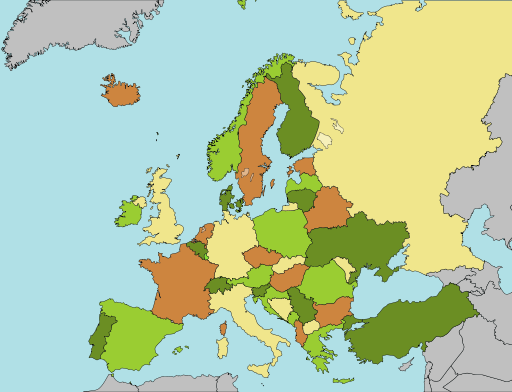Most computer and video games are written in USA or Japan, mainly through larger studios like EA, Microsoft, Sony, Nintendo and others.
This is typically because of the common platforms such as the main console platforms where the barriers of entry to the platform are very significant. The regular-computer (PC / Mac) and mobile platforms aren’t as exacting as the main console platforms and are in a better position to nurture more games developers. This is although Microsoft was running the XNA game-development program for their XBox 360 console which opened up game development for this platform.
The regular-computer and mobile platforms are opening up the “indie” game-development community which is independent of the main US and Japanese studios. A key example of this is Rovio, a Dutch games studio who built up the successful “Angry Birds” game franchise for the mobile platforms.
Europe has had a chance at the development of computer games through the 1980s while computing platforms like the Commodore Amiga which had an open-access software development environment existed. Similarly, when the Philips CD-I format gained a bit of a foothold in the European market in the mid 1990s, a few European games studios developed games like Burn Cycle for that format. But these were systems that had some level of popularity primarily in Europe.
Typically most of these efforts see their results achieve some sort of “domestic” popularity where the game is popular in its home market. But Rovio, a Finnish independent games studio, had cut through this barrier by releasing the popular “Angry Birds” game franchise, initially to the iOS and Android mobile platforms. But this was so popular worldwide that they ported it out to other non-mobile platforms like the PlayStation Portable and the two main regular-computing platforms, Windows and MacOS X.
The Android-driven OUYA games console is in a position to allow the independent games studios to write for the large-screen console market because it has access to the Google Play app store and the Android knowhow. This could open up paths for games studios in the under-represented areas like Europe and Oceania to cut in to the gaming mainstream. Similarly, there were a few other games consoles such as the “Steam Box” being premiered at the Consumer Electronics Show early this year. These console platforms, along with the Android and iOS mobile platforms, could light up the independent gaming scene and encourage the development of games titles in these areas.
As well, governments and local industry associations could establish incubation programs for the computer and video games industry in these areas. This could come in the form of, per se, a culture ministry treating gaming / interactive-entertainment development in a similar manner to other arts and culture endowment programs. On the other hand, an entertainment-content district like India’s “Bollywood” extending their brand and concept to interactive entertainment like what has happened with Hollywood.
Once you have other countries and areas having interactive-entertainment studios and engaged in computer and video games, it can allow a lot more to occur. For example, games can be reflective of different cultures rather than a Hollywood-led “aggressive” culture. Similarly, a game that is set in the modern era like some adventure and strategy games can be set up to reflect a locale other than the suburbia of USA.


